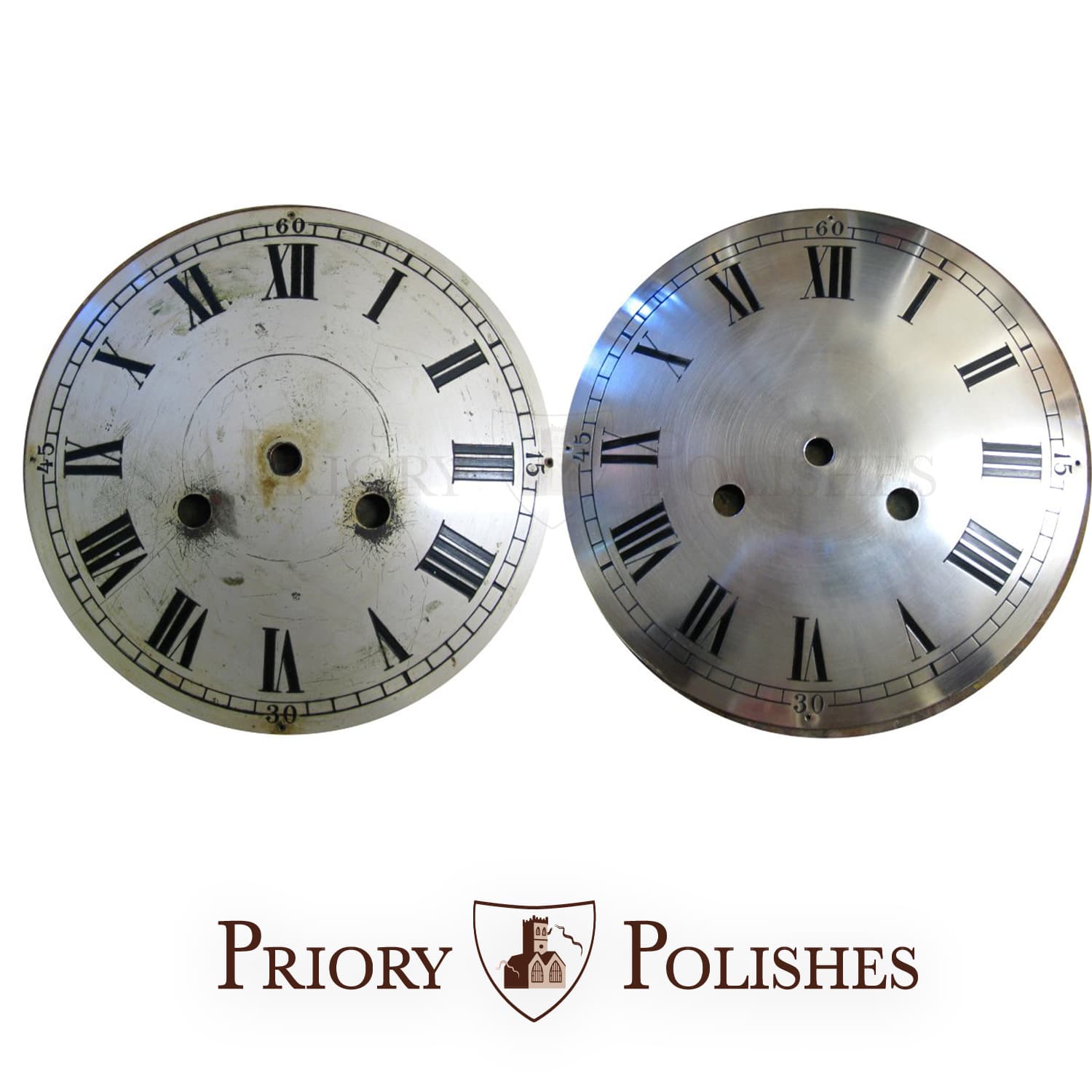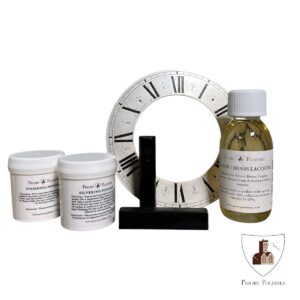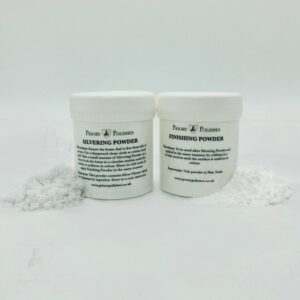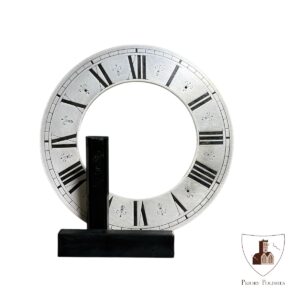Priory Polishes have been supplying the Horological clock trade for many years with unique restoration products. We specialise in silvering powder that restorers use to re-silver your clock dial. If you have a Barometer or Clock Dial in need of restoration and re-silvering we have everything you need in one handy kit. Our Clock Dial Restoration Silvering Kit comes with 50g of Silvering Powder, 50g of Finishing Powder, 100ml of Silver Brass Lacquer and one Stick of Engravers Wax. We do also sell these products separately if you only need to stock up on certain pieces to do the job. Below we will show you how to get your clock face to beautiful condition again.
How to Re-Silver your Clock Dial
- The first stage is to remove the distressed old finish and the damaged Silver. Clean the Silver Dial with a process of wet and dry sanding. Use wet and dry sanding paper 400 grit and submerge in water in-between sanding with the paper.
- Continue the above process, clean fully until all the original Silver and marks are removed.
- Use a foam sanding block or fine sanding paper (600 grit) to finish off in the direction of the grain of the metal and rinse. If a ‘spun’ effect is required, put a nail in a piece of old board and rotate the Dial around it while holding fine emery paper on the surface.
- Next you need to re-fill numerals in etched Dials with Black Engravers Wax. You can do this by heating a knife slightly (do not over heat) and melt a small blob of Wax on the tip to drip into the sections. You can also heat the Dial piece being filled slightly. If the old Wax is just cracked, hold the Dial over a heat source to warm the Wax just enough for the cracks to disappear. If the Wax is missing or insufficient, add a few flakes of it to the numerals and heat gently. If you need to cover a large area of engraving, melt over the entire piece and then when the Wax has cooled, use Steel Wool or wet and dry sanding paper to sand off the excess.
- Rub the surface back down again if necessary to be level with the Dial.
- Now you are ready to Silver your Dial. Apply the Silvering Powder onto very slightly dampened cotton wool and apply in a circular motion. Work this into the entire surface of the Dial, a small section at a time. The Silver Powder should be in a creamy consistency and you will need to keep the cotton wool damp the whole time you are applying it. As you apply you will start to see the Silver come through.
- Once you are happy with the colour of your Dial, you need to use the Finishing Powder, rub over again with damp cotton wool and in the direction of the grain of the Dial. Thoroughly rinse off and leave to dry.
- Finally you need to add a light coat of Silver / Brass Lacquer to preserve the finish and stop any oxidisation. The cellulose based Lacquer is fine to use on Clock Dials as long as the first coat is a very quick, light coat. It can then be applied heavier / thicker after the first coat has dried but usually we find one coat is enough. The Lacquer should only be applied thinly to engraved Dials as the Dial Wax will melt and run if too much Lacquer is used. To apply use a soft cotton cloth or a cotton wool pad; a quick swipe is the usual method then leave to dry before touching or attempting to add more Lacquer.
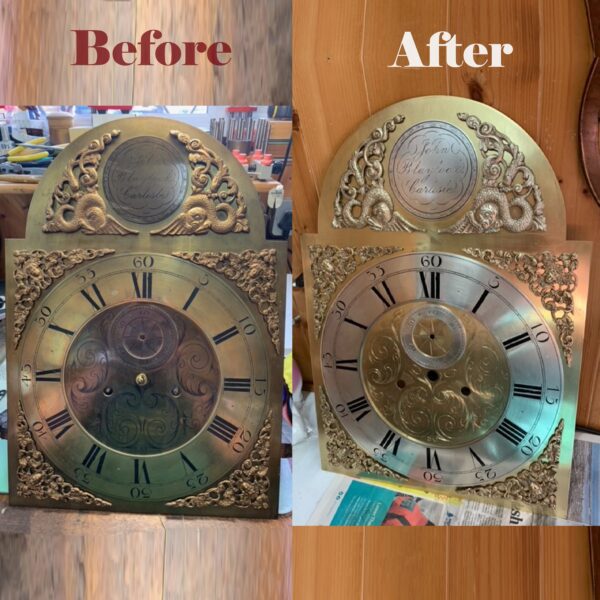
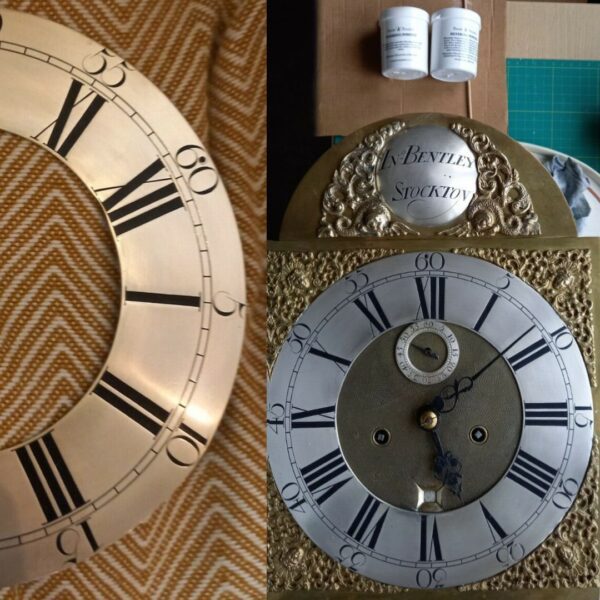
Some side notes –
Cleanliness is of paramount importance when Dial Silvering and almost all problems encountered are due to finger marks on the metal between cleaning and applying the powder. Silvering Powder acts by chemical reaction with the metal, and if this cannot take place evenly, an uneven colouring occurs.
Some clock dials can hold a lot more moisture than others. This can affect the silvering process overnight, making the brass patchy or loosing the silver effect on your dial. To resolve this, after the finishing powder process, dry quickly the front and back without spreading any grease or dirt from the back, so use different cloths. Then warm the dial quickly to ensure thorough dryness, either by hairdryer or well above a naked flame. This will ensure the cracks and stress fractures are totally dry. This will usually resolve the problem.
This powder will not work on Plated or Lacquered Dials; it is only designed to clean Brass and Copper but not Aluminium.
Many 20th century clock making companies actually copper plated their brass dials before Silvering. When silvering old dials that have been copper plated at manufacture, there can be a slight colour difference or patchiness if some of the copper shows through to the brass.
Silvering powder is not suitable to be applied on solder.
Products used in this blog
-
 Clock Dial Silvering Restoration Kit£29.95
Clock Dial Silvering Restoration Kit£29.95 -
 Antique Clock Dial Silvering Powder & Finishing PowderPrice range: £14.95 through £22.95
Antique Clock Dial Silvering Powder & Finishing PowderPrice range: £14.95 through £22.95 -
 Black Engravers Wax – Dial WaxPrice range: £5.99 through £6.99
Black Engravers Wax – Dial WaxPrice range: £5.99 through £6.99

